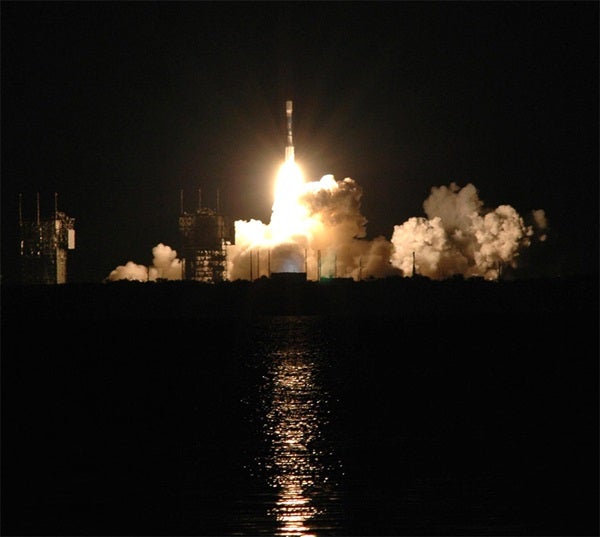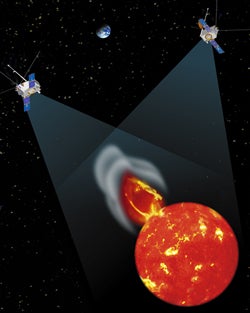NASA launched two identical spacecraft last night that, for the first time, will provide three-dimensional views of fiery eruptions on the Sun’s surface. The information gleaned from the Solar TErrestrial RElations Observatory (STEREO) mission not only will result in a better understanding of the Sun, but also will provide some warning of coronal mass ejections (CME) — huge clouds of plasma that explode from the Sun. When directed at our planet, these clouds of charged particles can potentially harm astronauts in space, damage orbiting satellites, and interrupt communication signals on terra firma.
“Each [CME] has something like the energy of 100 times the world’s nuclear weapon arsenal,” says Chris Davis, project scientist at Rutherford Appleton Laboratory in Chilton, England. Davis helped design STEREO’s heliospheric imager, one of 16 instruments scheduled to fly aboard each spacecraft.
This is precisely what STEREO is designed to do.
“We’re going to be able to see the Sun in 3-D and get depth perception on these CMEs in ways that we have never been able to before,” says Jim Adams, deputy project manager for the STEREO mission.
The two refrigerator-sized observatories, named STEREO A and B, will begin their mission by flying in elliptical orbits around the Earth and Moon’s orbit. After about 3 months, STEREO B will use the Moon’s gravity to sling shot into position “behind” Earth; STEREO A will follow a month later to a position “ahead” of Earth. From the two vantage points and with identical instrument packages aboard, the spacecraft will work together to provide the 3-D perspective. That perspective not only will include stereo images, but also the three-dimensional distribution of solar particles.
For example, the Sun-Earth Connection Coronal and Heliospheric Investigation (SECCHI) instrument package on each observatory will use a guide telescope, an extreme ultraviolet imager, two white-light coronagraphs, and a heliospheric imager to image CMEs from the moment they erupt to the time they collide with Earth’s magnetosphere.
At the same time, seven instruments that are part of the In-situ Measurements of Particles and CME Transients, or IMPACT package, will observe and measure the scattering of solar particles.
The STEREO mission is the second of three missions under NASA’s Solar Terrestrial Probes program designed to study space weather and its effects on Earth. The observatories will collect data for the stereo images for approximately 2 years. After that time, they will have drifted too far from each other to provide the three-dimensional view. However, according to Adams, the observatories will continue taking images for up to 5 years. Scientists will combine the STEREO data with that from SOHO in order to gain a different perspective.











